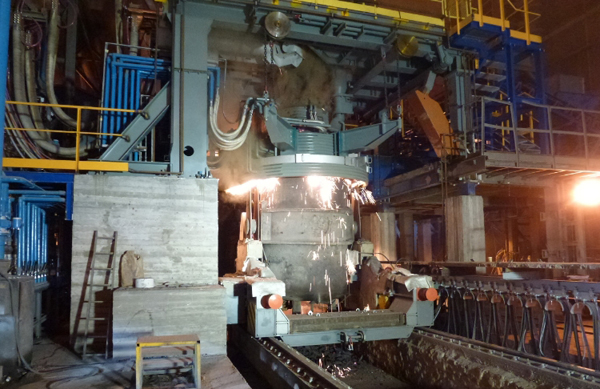
Ladle metallurgy furnaces are used to modify the steel chemistry by pushing thin wires of ferroalloys into the liquid steel. These modifications are needed to avoid nozzle clogging during casting and to control the morphology of oxide inclusions that form during steel deoxidation.
LMF slag bubbles carry metal oxides and inclusions to the surface of the liquid steel where they are swept away by a scraper or, in some shops, vacuumed into a slag pot parked beneath the steel.
Ladle metallurgy is a major process step in steelmaking as the liquid steel moves from the blast furnace or direct iron making shop to downstreaming shops like continuous casting. This is a critical stage in the overall steelmaking operation as it strongly impacts the quality of the finished product and the efficiency of the process.
The temperature of the molten steel is important since it directly influences the rate at which gas-metal fluid dynamic interactions and slag-metal reactions take place. The stability of the molten steel temperature is also important because fluctuations in temperature lead to a loss of energy which reduces the yield of the process.
The temperature of the molten steel can be controlled by using a vacuum degassing system or recirculating the liquid steel (e.g., RH, RH-OB and RH-KTB processes). Recirculating the molten steel allows for faster reheating and higher energy efficiency. In addition, most LFs use argon stirring in order to obtain a uniform temperature throughout the molten steel bath.
Ladle metallurgy is the refining of steel into specialty grades while still in the ladle. The main tasks are deoxidation, desulphurization, dephosphorization and controlled additions of alloying elements. Depending on the type of steel being produced, there are also tasks such as inclusion modification and shape control (i.e., the formation of strong inclusions that remain solid at hot rolling temperatures).
These reactions are exothermic and increase the liquid steel temperature. However, the molten steel loses additional heat by radiation from the surface and by the heat flux through the lining and shell. This can lead to large fluctuations in the liquid steel temperature.
Inert gas stirring (argon in recirculating systems, carbon dioxide in non-recirculating systems) is used to homogenize the liquid steel temperature and chemistry. This also prevents oxidation, traps inclusions and metal oxides, and provides means for desulphurization. In addition, powdered calcium or calcined dolomite is used for slag-to-steel transfer and to modify the oxides formed during the slag melting process.
Using a ladle furnace relieves the primary steelmaking process of many secondary refining operations and also allows for more precise temperature control and alloy composition. In particular, the LF can achieve homogenization of temperature and chemical composition through stirring with inert gas (argon) bubbled through porous plugs in the bottom of the refractory lined ladle. This stirring also enables the removal of unwanted non-metallic inclusions by liquid steel / slag reactions and also a means for deep desulphurization.
The metallurgical treatment of liquid steel in the LF is done through additions of deoxidizers, slag formers and small amounts of alloying elements. Normally, these materials are introduced into the molten steel through powder injection with a refractory lance.
Calcium is normally injected into the molten steel to modify the morphology of the sulfide inclusions. This is also known as inclusion morphology modification or control. The morphology of these inclusions changes to globular, liquid calcium aluminates or calcium silicates reducing the through-thickness cracking caused by elongated manganese sulfides.

Calcium, symbol Ca (atomic number 20), is one of the five most abundant elements in the earth’s crust. It is found mainly in limestone and the fossilized remains of sea life, but also in gypsum, anhydrite and fluorite. Quicklime is the most commonly used form of this element in the steel industry.
It acts as a flux, lowering the concentration of impurities in the liquid steel (above all silica and alumina but also silicon and sulphur) by reacting with them to form slag. This increases the deoxidation efficiency and improves the cleanliness of the steel.
In addition, calcium treatment significantly increases the machinability of steels by modifying the inclusion morphology. This is especially important for hot-rolled sheet grades that are prone to sulfide inclusions which clog the nozzles and cause poor through-thickness ductility. Calcium treatment transforms these hard alumina inclusions into soft calcium aluminates and modifies the shape of sulfides, thus giving better control over the damage mechanisms during cold deformation [18]. Figure 1.7.7 shows stability regions of solid oxides and liquid calcium aluminates as well as of solid CaS for different oxygen contents and S-contents at 1550 degC.

Write a Message